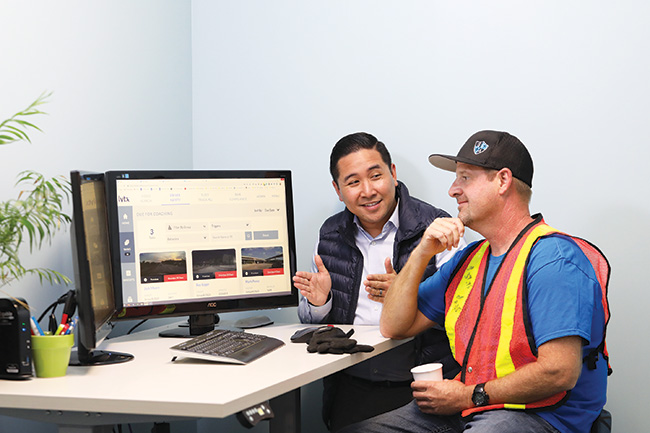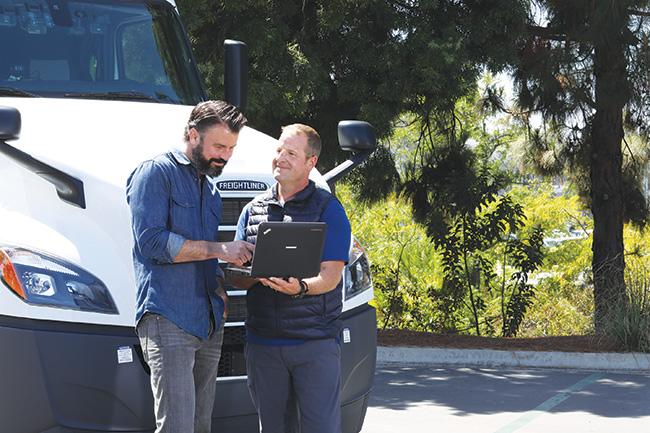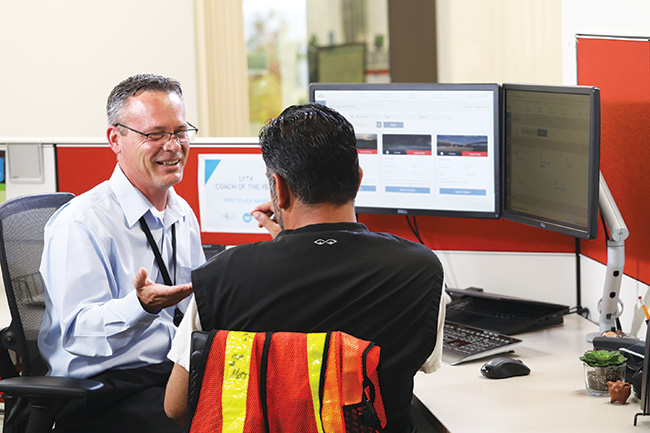Today’s top fleets are supporting and retaining drivers with positive coaching from empowered managers. Using video safety technology and deliberate organizational strategies, both drivers and managers can have the right conversations at the right times to successfully mitigate risk.
By Jeff Martin
Driver retention and development is a challenge that has been dominating headlines in the waste and recycling industry. To help counter this issue, we need to look at the bigger picture and the critical role that managers play in keeping their best drivers on staff. When managers are also good coaches, drivers are happier, more engaged, and longer tenured. It is a cyclical relationship and one that companies should foster to not only improve retention rates, but also safety and productivity across the fleet.
Effective coaching is a multi-faceted effort, but your company’s North Star must always be to put drivers in a winning position. And that starts with rebalancing and repurposing the manager.

Photos courtesy of Lytx.
Setting Managers Up for Success
Good coaching starts with making sure managers have the time and focus to invest in drivers. If your route and operations managers are trying to keep safety first and foremost, while also juggling the needs of drivers, customers, and operations, coaching will suffer. And safety will suffer next.
There are a few ways today’s leading waste industry companies are right sizing their managers’ workloads to set them up for coaching success. The first is to make driver-to-manager ratios reasonable and achievable. This may mean cutting your ratio from 20:1 down to 12:1 (or even lower).
The second is to match the skillset of drivers and managers. For example, a company recently restructured their safety program because their most experienced managers were coaching tenured, roll-off route drivers, whereas more junior managers were coaching newer, residential route drivers. The company wisely recognized this mismatch and flipped everything to pair the expert coaches with rookie drivers and newer managers with veteran drivers. So, balancing skillsets is essential for effective coaching, and will also factor into the ideal manager-to-coach ratio. Managers who coach less experienced drivers will need lower ratios so they have the time to focus on helping them improve behaviors, but you can likely increase the ratios with experienced drivers who typically need less coaching.
Finally, finding opportunities to eliminate wasteful steps in a manager’s day and shifting time-intensive tasks to people who are better able to handle those items is an important part of setting managers up for success. For example, can a service representative help a customer determine if it is possible to move their container to the other side of a parking lot? Yes, especially using fleet technology or something as straightforward as Google Earth. This saves the manager from asking the driver to handle the request or going onsite themselves.
When you lift extra work off managers’ shoulders, create reasonable manager-to-driver ratios, and match skillsets, your team is primed to deliver great coaching.

Leveraging Technology for a Better Driver Experience
Once your fleet has created the ideal environment for managers to coach, putting innovative and effective technology into play creates a better experience for drivers. Modern fleet safety systems allow managers to have the right conversations with the right drivers at the right time for the right reason.
More specifically, video safety technology with machine vision and artificial intelligence (MV+AI) can alert drivers to risky behaviors (such as picking up a cell phone) as they happen. Drivers receive a distracted alert and can self-coach in the moment, which helps them maintain their independence while also freeing up manager time and improving overall fleet safety. Video also provides much needed context as to what is happening on the roadways, helping managers and drivers have qualified coaching discussions and more easily gain consensus.
Also, telematics and fleet tracking technology give dispatch and call center teams the opportunity to operate more efficiently and provide better service. By knowing exactly when and where vehicles are located, these teams can update customers promptly, reroute drivers, and smoothly navigate emergencies. This not only improves safety and service, but it also eliminates stress for drivers and managers—issues like service confirmations will not dilute coaching conversations because they have been addressed before they escalated into problems.
Technology’s configurability is another benefit to both drivers and managers. Each company can set up their safety program tools to suit their culture. For example, you can choose to give a driver one or three warnings per day before a coaching conversation. Managers get risk reports that track metrics like the number of alerts per driver, revealing whether there is a negative trend emerging that requires a quick meeting with all drivers, or whether one driver in particular needs more support. Coaching workflows can also be configured to offer self, remote, or in-person coaching for individuals or groups, so you can meet drivers wherever they are. The variety of ways you can tailor your safety technology empowers managers to be better coaches and helps drivers focus on what matters most to your fleet.

Using Recognition to Foster Trust
Studies have repeatedly shown that drivers are not just financially motivated—they crave respect, too. The final key to putting drivers in a winning position is training managers to have balanced coaching sessions, where appreciation is present in every conversation about continuous behavior improvement.
For example, it is an entirely different conversation when a manager says, “Tell me about yesterday’s event,” versus “First off, I want to say thank you for not being on your cell phone. We are really seeing cell phone use drop across the fleet and that is important. But tell me about yesterday’s following too close event.” When you are able to recognize a driver’s efforts, it fosters trust and builds a manager-driver bond that is invaluable. This ultimately results in a better retention rate at both the frontline driver and manager level.
There is magic in the one-on-one session, but also in the group experience. Companies with the best coaching programs often incorporate a practice called peer share. In a group setting, the manager will show a video where a driver exhibited good decision making and safe behaviors. The driver stands up in front of their peers to explain what happened and receives some well-deserved recognition. This has multiple benefits—from making the driver feel appreciated and building consensus to setting clear safety expectations. There are countless ways managers can weave recognition into their driver coaching initiatives and there is no doubt it leads to increased retention and safety.
A Winning Position
Effective coaching boils down to making sure that you are putting managers and drivers in a winning position. Again, the best companies in the industry are having the right conversations with the right drivers at the right time for the right reason. All of these “rights” build trust and consensus between drivers and managers, which improves job satisfaction and breeds safer behaviors across the fleet. And, ultimately, drivers and managers will not want to jump ship on a company that is run efficiently, safely, and with a staff-centric philosophy. | WA
Jeff Martin joined the Lytx team in August 2022 as an executive specializing in the transportation, distribution, and field services sectors. Jeff has decades of operational experience in architecting, directing, and continuously improving safety programs. He started at Waste Management (WM) in 1996 and held several positions, including Vice President of WM Safety Services LLC. Jeff is the former Safety Chairman of the National Waste & Recycling Association (NWRA) Safety Committee and is currently serving as Chairman Emeritus. He is also an active member of various associations that serve the commercial transportation and service sectors. For more information, visit www.lytx.com.
